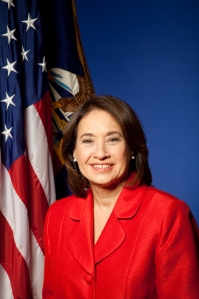 By Sara Manzano-Díaz, Director of the U.S. Department of Labor’s Women’s Bureau
By Sara Manzano-Díaz, Director of the U.S. Department of Labor’s Women’s Bureau
This is a guest blog post on the important theme of Equal Pay Day. The struggle to gain equality in pay for women is ongoing, and affects women and their families.
As the economy of the United States slowly recovers, one faction of the population is still struggling for wage equality—women. The American workforce today is more female and more diverse. Women account for nearly half of our nation’s workers. Yet, women on average still earn 20 percent less than their male counterparts.
Since passage of the landmark Equal Pay Act in 1963, the pay gap has steadily narrowed by just one-half a cent each year. Over the past five decades the landscape of pay equity for women has remained one of “haves” and “have nots.” This is particularly true for women of color. Data indicates that the wages of women of color significantly lag that of whites.
According to recent reports by the U. S. Department of Labor’s Bureau of Labor Statistics, women who were full-time wage and salary workers had median weekly earnings of $657 compared to $819 for men. When you look at the wages of African American and Hispanic women, however, the wage gap widens.
For example, African American women earn about 70 cents and Latinas about 60 cents of every dollar paid to all men. These aren’t simply statistics, they’re real numbers that affect the pocketbooks of women who face the day-to-day bread and butter issues of taking care of their families.
So, why does the pay gap matter? The pay gap shines a bright light on the disparity of income available to maintain the households of American families, particularly those of single women and women of color. For millions of working women, the gap means 20 percent less income to pay for housing, gas to get to work, utilities, food, college education for children, and retirement savings.
Over a 40-year career, a woman cumulatively loses nearly $380,000 in earnings. For the average working woman that is almost $150 a week in lost household income to sustain their families. Equal pay is not just a woman’s issue—it’s a family issue.
As a woman and a public servant, I am proud of the Labor Department’s role in advocating for issues that positively improve equal pay for women and their families. And, we want to assure women that this administration will continue to enforce the laws that protect wages, to level the playing field for employers who play by the rules, and to work toward fixing policies that impact women in the workplace.
And as a working woman, I know what my missing 20 percent has cost me over my lifetime. What has that 20 percent cost your family?
More information on the impact of the pay gap is available at http://www.dol.gov/wb/equal-pay-toolkit-20110412.htm.
Sara Manzano-Díaz is Director of the U. S. Department of Labor’s Women’s Bureau.

